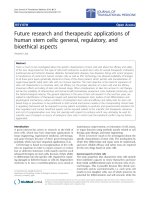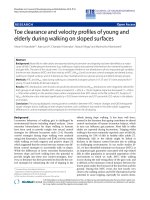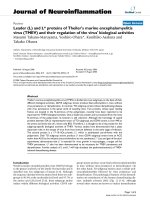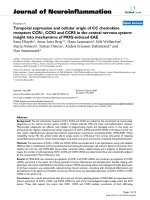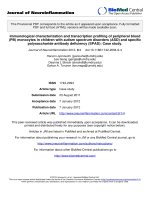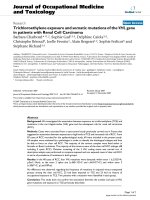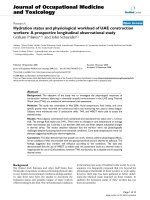báo cáo hóa học:" Bone quality and growth characteristics of growth plates following limb transplantation between animals of different ages - Results of an experimental study in male syngeneic rats" potx
Bạn đang xem bản rút gọn của tài liệu. Xem và tải ngay bản đầy đủ của tài liệu tại đây (663.12 KB, 7 trang )
RESEARCH ARTIC LE Open Access
Bone quality and growth characteristics of
growth plates following limb transplantation
between animals of different ages - Results of an
experimental study in male syngeneic rats
Hitesh N Modi, Seung Woo Suh
*
, Boopalan Prjvc, Jae-Young Hong, Jae-Hyuk Yang, Young-Hwan Park,
Jae-Moon Lee and Yong-Hyon Kwon
Abstract
Introduction: The purpose of this study was to identify graft osteoporosis post transplantation by micro-CT
analysis, and the growth potential of growth plates in the transplanted limb.
Methods: Ten juvenile to juvenile and five juvenile to adult hind limb transplants were performed in male
syngeneic Lewis rats. Upper tibial bone density in isochronograft and heterochronograft limbs was measured by
3D micro-CT and compared with that of the opposite non-operated limbs.
Results: We observed inferior bone quality (p < 0.05) in heterochronografts compared to isochronografts. After
transplantation, isochronografts did not exhibit increases in tibial lengths compared to opposite juvenile non-
operated tibias (p = 0.66) or heterochronograft tibias (p = 0.61). However, significant differences were observed
between heterochrongraft tibial lengths when and opposite adult non operated tibial lengths (p < 0.001).
Conclusions: Age dependent alterations affect bone quality, resulting in post transplantation osteoporosis in
heterochronografts, but not isochronografts. However, the growth plates of transplanted limbs retain their
properties of longitudinal growth and continue to grow at the same rate.
Keywords: Limb transplant, isochronografts, heterochronografts, osteoporosis, growth potentials of growth plate
Background
Osteoporosis often develops in transplanted and grafted
bone after bone transplantation or grafting [1-4] due to
revascularization and creeping substitution that occur
during the repair process. Kline et al. [1] proposed that
lack of weight bearing post transplantation and subse-
quent stress shielding are the causative factors of post
transplantation osteoporosis.
Increases in the length of long bones occur by
enchondral ossification at the growth plates (meta-
physes). Each growth plate has an inherent mech anism
for determining growth rate and limb morphology [1].
In addition, growth at the physes is influenced by a vari-
ety of hormones that have permissive effects and enable
the growth plated to achieve their maximum growt h
potential. C growth hormone,thyroxine,somatomedin
C (insulin like growth f actor I), insulin like growth fac-
tor II, cortisol, insulin, and sex hormones all play impor-
tant roles in regulating growth plate development and
rates o f limb growth [5-9]. There is a complex interac-
tion between these different hormonal factors. Levels of
these hormones within the body show remarkable differ-
ences during growth phases (immature skeleton) and
adult phases (completed skeletal m aturity). But what
happens when a growth plate with significant growth
potential is placed in an adult hormona l environment?
Will it retain its property of promoting longitudinal
growth in the changed hormonal milieu? If yes, then is
this increase in length different from the increase in
length occurring in a juvenile hormonal environment?
* Correspondence:
Scoliosis Research Institute, Department of Orthopedics, Korea University
Guro Hospital, Seoul, Korea
Modi et al. Journal of Orthopaedic Surgery and Research 2011, 6:53
/>© 2011 Modi et al; licensee BioMed Central Ltd. This is an Open Access article distribute d under the terms of t he Creative Commons
Attribution License ( .0), which permits unrestricted use, distribution, and reproduction in
any medium, provid ed the original work is properly cited.
Previous studies have attempted to understand the
behavior of juvenile growth plates in adult bodies by
limb tran splants between animals o f different ages.
However, they yield conflicting results; some report
that juvenile growth plates attain full growth potential
in the adult body[1,10] while others report that juve-
nile growth plates attain only partial growth potential
in the adult hormonal environment[11,12]. Vascular-
ized growth plate transplants are now fe asible alterna-
tives for the management of growth plate damage by
tumor, infection, trauma or congenital anomalies. Pre-
vious reports indicate that microvasc ular epiphyseal
transplants may successfully be used to reconstruct the
extremities of children whose epiphyseal plates were
damaged or surgically removed as a result of disease
or trauma [13-17]. These studies demonstrated both
the reconstruction of bony defects and restoration of
longitudinal growth.
The performance of limb transplants between male
syngeneic Lewis rats of different ages constitutes a
unique experimental model, and is made possible by
advances in microvascular surgery that allow us to
study the pathogenesis of post bone transplantation
osteoporosis. Therefore, the purpose of this study was,
to determine the level of osteoporosis using micro CT
post limb transplantation in this animal model, and to
determine t he effects of age on growth plate potential.
Methods
After obtaining approval from the University Animal
Care and Use Committee (ACU C No BU08026 we
obtained male syngen eic Lewis rats for use in the pre-
sent study. Two groups of rats that differed only in age
were used in the present study. The first group con-
sisted of 10 recipient juvenile rats (mean age 23.8 days,
range21-28days).Thesecondgroupconsistedof5
recipient adult rats (mean age 72.4 days, range 71-77
days). The hind limbs of these rats were divided into
two experimental groups as follows:
Group 1: Microvascular transplants of the right hind
limbs of 10 juvenile donors into 10 juvenile recipients
served as isochronografts.
Group 2: Microvascular transplants of the right hind
limb s of 5 juvenile donors i nto 5 adult recipients served
as heterochronografts.
All surgical procedures were performed unde r general
anesthesia, which was induced and maintained by
administering single injected intraperitoneal doses of
ketamine. Two surgical teams were involved: one team
was dedicated to harvesting the donor limbs from 15
juvenile rats while the other performed microvascular
anastomosis of the donor limbs to the recipient stumps
of 10 juvenile and 5 adu lt rats. The donor juvenile limbs
were harvested by above knee amputation at the mid-
femur diaphysis level. The femoral vessels of the donor
limbs were the last structures divided in an attempt to
limit the ischemic time to less than 1 hour. This was
followed by microvascular a nastomosis of the donor
limbtotherecipientaboveknee(AK)amputation
stumps of 10 juvenile and 5 adult rats. Bony stabilization
was first achieved by inserting an int ramedullary 18G
needle into the femur. This was followed by microvascu-
lar anastomosis of the femoral arteries with 10-0 nylon
interrupted sutures. Femoral and sciatic nerve anasto-
mosis were then performed with 10-0 nylon, and finally
the corresponding musc le groups were sutured. All rats
received prophylactic antibiotics in the form of intra-
muscular injections of penicillin, one dose po stopera-
tively per animal.
Post tra nsplantation, the rats were housed separately
and were allowed to bear weight on the transplanted
limbs as p ain allowed. Food was dispensed above a 15°
inclined platform so that the animals would be forced to
bear weight to reach the food. All operated animals
were observed engaging in this behavior. Increases in
the lengths of the transplanted limbs were then moni-
tored by calculating tibial lengths using serial postopera-
tive anteroposterior radiograms. Tibial length was
measured from the joint lines at the knee and ankle
joints, which included the highest growth potential areas
of the epiphyses. While taking radiograms, the rats were
sedated with single doses of intraperitoneal ketamine
and placed in the prone position with both knee joints
in flexion, with the anterior side of the tibia facing the
X-ray tube. The first set of radiograms was taken 3
weeks after transplantation (Figure 1a) . All animals were
sacrificed 10 weeks post transplantation by injection
overdose of intraperitoneal thiopentone. The second and
last set of radiograms was taken at this time (Figure 1b).
The i ncreases in tibial length of the transplanted limbs
were measured by calculating the difference between the
lengths of the tibia a t the 3- and 10-week post-trans-
plantation radiograms. Similarly, the increases in tibial
length of the contralateral non-operated hind limbs dur-
ing the same time interval were also calculated. In order
to ensure accuracy, all radiographs were scanned and
tibial lengths were measured using the software program
Rapidia Version 2.7 (INFINITT, Seoul, Korea).
The following results were evaluated separately:
Sub group 1 - Comparisons of the increases in tibial
lengths of transplanted isochronograft (juvenile to juve-
nile) limbs, and increases in tibial lengths of the corre-
sponding contralateral non-operated hind limbs in the
same animals.
Sub group 2 - Comparisons of the increases in tibial
lengths of transplanted isochronograft (juvenile to juve-
nile) limbs and tr ansplanted heterochronograft (juven ile
to adult) limbs.
Modi et al. Journal of Orthopaedic Surgery and Research 2011, 6:53
/>Page 2 of 7
Sub group 3 - Comparisons of the increases in tibial
lengths of heterochronograft limbs and corresponding
contralateral non-operated hind limbs in adult animals.
Limbs from completely separate animals (e.g., juvenile
to juvenile isochronografts versus juvenile to adult het-
erochronografts; sub group 2) were compared using Stu-
dent’s t-test for independent groups, while limbs of the
same animal (e.g., juvenile to juvenile isochronografts
versus contralateral nonoperated limbs of the juvenile
animals; sub group 1) were compared using Student’s t
test for correlated groups. P-values less than 0.05 were
considered significant.
To assess the bone qualit y in the transplanted limbs,
the tibiae of both isochronografts and heterochrono-
grafts were harvested from sacrificed animals. A fter
stripping the harvested tibiae of all soft ti ssue the bones
were prepared by precision sawing and subjected to a
high resolution 3-dimensional micro-CT analysis (μ-CT-
40, Scanco Medical AG, Zurich, Switzerland) at the
upper third portion of the tibial diaphyses. The scanned
images were used for 3-dimensional reconstruction of
cubic voxel sizes 31 × 31 × 31 μm
3
(Figure 2). Each
three dimensional image dataset consisted of approxi-
mately 200 micro-CT slide images (1024 × 1024 pixels)
with 16 bit gray levels. Micro CT images were segmen-
ted using previously described methods [18]. Using
accurate thre e dimensional data sets, bone volume frac-
tion (VF), trabecular number (Tb.N), trabecular thick-
ness (Tb.Th), trabecular separation (Tb.Sp), bone
surface to total volume ratio (BS/TV) and bone surface
to bone volume ratio (BS/BV) were calculated based on
unbiased, assumption free, 3-dimensional methods. The
results w ere presented as mean and SD. The micro CT
parameter values in the isochronograft group were then
compared with the heterograft group using unpaired
Student’s t-tests. P-values less than 0.05 were considered
significant.
Results
The micro-CT 3D parameters of transplanted bone in
isochronograft and heterochronograft limbs for
measuring osteoporosis (Table 1)
The parameter values of bone mass indicated signifi-
cantly inferior bone quality of transplanted bone in the
heterochronograft group as compared to the bone qual-
ity in the isochronograft group. The 3D fractional bone
volume (VF) in the heterochronograft group was signifi-
cantly less than the bone volume fraction of the isochro-
nograft group (p = 0.009). In the heterochronograft
group, the values of Tb.N were significantly less (p =
0.001) than the values in the isochronograft group. The
values of Tb.Sp were significantly increased in the het-
erochronograft group compared to the isochronograft
group (p < 0.001) indicating less trabecular density in
the heterochronograft group than the isochronograft
group. The param eter s of Tb.T h were sign ific antly less
in the heterochronograft group compared to the iso-
chronograft group (p = 0.028) indicating thinner and
weaker trabeculae in the heterochronograft group than
the isochronograft group. The BS/TV in the heterochro-
nograft group was significantly smaller than that of the
Figure 2 3-D micro CT images of tibial diaphysis. 3-D micro-CT
image taken at the upper third of tibial diaphysis.
Figure 1 Radiogram of rat limbs after 3 and 10 weeks of transplantation. a: Radiogram of rat hind limbs taken 3 weeks after
transplantation - tibial lengths of both transplanted and opposite non operated limbs were measured. b: Radiograph of rat hind limbs 10 weeks
after transplantation, showing the increased length of the tibias of transplanted limbs as well as opposite non operated limbs.
Modi et al. Journal of Orthopaedic Surgery and Research 2011, 6:53
/>Page 3 of 7
isochronograft group (p < 0.001). Finally the BS/BV was
significantly higher (p = 0.008) in the heterochronograft
group compared to the isochronograft group.
Comparisons of increases in length of transplanted limbs
among the different subgroups (Table 2)
There were similar increases in the lengths of juvenile
isochronograft limbs and non-operated contra lateral
hind limbs (sub group 1). During the experimental per-
iod the tibiae in the juvenile isochronograft limbs grew
in length by 1.2 3 ± 0.13 cm (range, 1.0-1.4 cm). This
was not significantly different (p = 0.66) (table 3) from
the increases in tibial length of the non-operated con-
tralateral hind limbs of these juvenile animals, which
grew by 1.28 ± 0.19 cm (range, 1.0-1.7 cm) during the
same period. Similarly, there was an increase in the
length of the juvenile to juvenile isochronograft hin-
dlimbs when compared t o the increase in length of the
juvenile to adult heterochronograft hind limbs (sub
group 2). The tibiae of the juvenile isochronograft hind
limbs grew in length by 1.23 ± 0.13 cm (range, 1.0-1.4
cm) during the experimental period. This was not signif-
icantly different (p = 0.61) (table 3) from the increases
in tibial length of the juvenile to adult heterochronograft
hindlimbs, which grew by 1.22 ± 0.18 cm (range, 1.0-1.4
cm) during the same time interval. However, the
increases in length of juvenile to adult heterochronograft
hindlimbs, were different compared to the increases in
length of adult non-operated contra lateral hind limb s
(sub group 3). During the experimental period, the
tibiae of the juvenile to adult heterochronograft hind
limb s increased in length by 1.22 ± 0.18 cm (ran ge, 1.0-
1.4 cm) which was significantly different (p < 0.001)
(table 3) from the increase in tibial length of the adult
non-operated contra lateral hind limbs, which increased
in length by 0.50 ± 0.30 cm (range, 0-0.8 cm) during the
same time interval.
Discussion
Through our experimental study we found that the
decrease in bone quality typically following limb trans-
plant depends in part on recipient factors. As measured
by micro-CT, all parameters of bone qu ality wer e signif-
icantly better in limbs transplanted between juvenile rats
than between limbs transplanted from juvenile rats to
adult r ats, indicating that age related alterations in the
hormonal milieu in the adult rats resulted in inferior
bone quality in the transplanted limbs. To our knowl-
edge, mea suring bone quality using 3-D micro-CT, and
comparing bone growth simultaneously, was performed
for the first time in this study, which makes this study
unique.
Kline et al. [1] noted that osteoporosis occurred fol-
lowing limb transplantation between animals of different
ages; however, that study primarily dealt with the
growth characteristics of growth plates following limb
transplantation, without establishing the relationship
between the degree of osteoporosis and the age of the
recipient animal. They attributed the post transplanta-
tion osteoporosis to factors relating to both the non-
weight-bearing, and lack of external stress conditions
following limb transp lantation. However, their hypo th-
esis may be incorrect, because in a previous hindlimb
transplanted rat model there were no significant differ-
ences in functional improvement between rats that
received physiotherapy and rats that did not, except for
foot drop [19]. However, they did not evaluate bone
quality in this study.
From the results of our experimental study we found
that host dependent age related hormonal factors play a
Table 1 The micro-CT 3D parameters of transplanted bone in isochronograft and heterochronograft limbs
Isochronograft(n = 10) Mean ± SD (Range) Heterochronograft(n = 5) Mean ± SD (Range) t value p value
BV/TV 0.3 ± 0.177 (0.09-0.38) 0.055 ± 0.023 (0.028-0.081) 3.03 0.0096
Tb.N (1/mm) 3.924 ± 1.249 (1.563-5.650) 1.42 ± 0.56 (0.819-1.862) 4.21 0.0010
Tb.Th (mm) 0.0697 ± 0.0242 (0.037-0.112) 0.0421 ± 0.003 (0.039-0.047) 2.47 0.028
Tb. Sp (mm) 0.221 ± 0.15 (0.083-0.583) 0.757 ± 0.308 (0.421-1.174) -4.63 0.0005
BS/TV (1/mm) 10.1 ± 2.22 (7.197-13.295) 2.69 ± 1.10 (1.419-3.863) 7.01 < 0.0001
BS/BV (1/mm) 35.4 ± 9.40 (22.70-53.35) 48.9 ± 1.76 (9.257 to 54.27) -3.13 0.0080
Abbreviations: Tb.N = Trabecular number; Tb.Th = Trabecular thickness; Tb.Sp = Trabecular Separation; BV = Bone Volume; TV = Tissue Volume; BS = Bone
Surface; ns = no significance, SD = Standard Deviation.
Table 2 Data show animal groups and increases in tibial lengths during the experimental period
n Starting length (cm) Final Length (cm) Average net growth (cm)
Juvenile isochronografts 10 3.52 ± 0.24 (3.3-3.8 cm) 4.75 ± 0.21 (4.4-5.2 cm) 1.23 ± 0.13 (1.0-1.4 cm)
Juvenile contra lateral limbs 10 3.58 ± 0.32 (3.5-3.9 cm) 4.86 ± 0.23 (4.8-5.6 cm) 1.28 ± 0.19 (1.0-1.7 cm)
Juvenile-adult heterochronografts 5 3.56 ± 0.36 (3.4-3.9 cm) 4.78 ± 0.61 (3.9-5.3 cm) 1.22 ± 0.18 (1.0-1.4 cm)
Adult contra lateral limbs 5 4.58 ± 0.43 (4.1-5.1 cm) 5.08 ± 0.38 (4.8-5.7 cm) 0.50 ± 0.30 (0.0-0.80 cm)
Modi et al. Journal of Orthopaedic Surgery and Research 2011, 6:53
/>Page 4 of 7
vital role in the etio pathogenesis of post transplantation
osteoporosis. Gourian et al. [20] showed that age related
changes in bone mineral content (BMC) are due to the
mineralization process itself and not imbalance in the
remodeling process. Tissue age can vary within the
same bone specimen due to reabsorption of bone by
osteoclasts and formation by osteoblasts. Juvenile bone
placed in an adult hormonal environment (heterochro-
nografts) suffers muc h greater bone loss than juvenile
bone placed in a juvenile hormonal environment (iso-
chronografts). Of course, other factors such as circula-
tion, neuronal control, bodily responses to stress and
transplantation also play roles in maintaining the bone
quality of transplanted allogenic bone from the donor.
The results of the above experiment suggest that even
after transplanting the limbs of juvenile animals into
adu lt animals (heterochronografts), the growth plates in
the transplanted limbs retained their properties of longi-
tudinal growth and continued to grow at the same rate
in the new adult environme nt as they would have in the
juvenile environment. The increase in length of the het-
erochronograft limbs was not significantly different from
the increase in length of the isochronograft limbs. In
addition, the increase in length of the isochronograft
limbs was not significantly different from the increase in
length of the non-operated contralateral hind limbs.
Our results are similar to those of Kline et al. [1], who
reported that a mature hormonal environment does not
inhibit the longitud inal growth of immature growth
plates. Kline et al. observed maintenance of growth in
juvenile limbs transplanted into adult rats. They also
studied growth plate morphology in transplanted limbs,
and observed that all transplanted limbs demonstrate
maintenance of gr owth plate morphology and colum nar
organization [1]. However, they did not assess the bone
quality among these groups.
The increase in length of the heterochronograft limbs
was, however, significantly greater than the increase in
length of the non-operated contra lateral hind limbs of
the adult rats. In other words, after the age of 3 weeks,
the internal environment of the host ceases to have a
decisive role in the determination of the growth charac-
teristics of the growth plate, and the increase in length
of the growth plate is primarily determined by local
transplantable factors that are expressed prior to trans-
plantation by interactions between the inducing factors
and inherited genomes. We can explain the increase in
length of the adult non-operated limbs by the fact that
the growth pattern in rats differs from that in humans,
in that the growth plates in rats remain open later into
adult life, though the growth rate at 10 weeks of age is a
fraction of the rate at 3 weeks of age [21,22]. The tem-
poral analysis of rat growth plate shows cessation of
growth with age, despite the presence of a physis [23].
For this reason, we s hould be cautious regarding blind
extrapolation of these results to humans, and rather,
emphasize that these findings need to be confirmed in a
clinical setting. Chiu et al. [12], in a similar study invol-
ving limb transplantation between animals of different
ages, observed that the transplanted bone achieved only
70% of the normal growth in length. This finding was
corroborated by Drzewiecki et al. [11] who also found
that after limb transplantation the transplanted bone
could not achieve normal growth potential, but noted
that the maximum growth (91% of normal) was
observed in heterochronografts. However, in both of
these studies the nerves of the transplanted limbs were
not sutured, and the animals were non- weig ht bearing,
so the failure to achieve full growth could be attributed
to the effects of denervation and lack of external stress.
However, in our exper iment blood vessels and nerves
were sutured with microvascular anastomosis, minimiz-
ing the ischemic time, and therefore we could allow
weight bearing in the subject group.
Stevens et al. [24] studied the growth of epiphyseal
plate allografts after microvascular transplantation in
rabbits of different ages, and found that the growth rate
depended on the age of the donor epiphyseal plate and
was independent of the age of the recipient. Glickman
et al. [25] studied epiphyseal growth after microvascular
transplantation to sites of different growth potential,
and reaffirmed that growth potential of an epiphyseal
plate transplant is a function of the donor, irrespective
of the recipient site to which it is transplanted. Our
report would further support their findings that the
growth of epiphysis is an inherent property of the
donor, while the quality of bone depends upon the
internal environment of recipient’s body.
There are reports in which microv ascular epiphyseal
transplants have be en used to reconstruct the ext remi-
ties of children whose epiphyseal plates were damaged
or surgically removed as a result of disease or trauma.
Vilkki [13] performed microvascular transplantations o f
the metatarsophalangeal joint with w hole metatarsal
Table 3 Comparison between tibial length increases of various groups during the experimental period
t value p value
Juvenile isochronograft vs juvenile contra lateral non-operated limb (Sub Group 1) - 0.447 0.66
Juvenile isochronograft vs juvenile-adult heterochronograft (Sub Group 2) 0.529 0.61
Juvenile-adult heterochronograft vs adult contra lateral non-operated limb (Sub Group 3) -5.6 <0.001
Modi et al. Journal of Orthopaedic Surgery and Research 2011, 6:53
/>Page 5 of 7
bone in the treatment of radial club hand in nine chil-
dren. At the average follow-up of six years they found
that the deformity of t he wrist had been reduced and
growth of the ulna had been maintained due to intact
functions of transplanted metatarsophalangeal joints.
Innocenti et al [14-17] described the treatment of l oss
of the distal part of the radius, including the physi s and
epiphysis in skeletally immature patients, by performing
vascularized proximal fibula transfers based on the ante-
rior tibial artery. This included the physis, and a variable
length of the diaphysis, and found a consistent and pre-
dictable longitudinal growth of the transferred fibula.
On the basis of these findings, Innocenti et al. proposed
that vascularized epiphys eal transf er is the only possible
procedure that can solve the dual problem of replace-
ment of osseous defect and restoration of longitudinal
growth in the case of loss or damage to epiphyseal
plates. Our report also supports the clinical implications
of transferring intact joints with epiphyseal growth
potentials on various congenital disorders , like epiphy-
seal dyplasia, tibial hemimelia, a nd psuedarthor osis of
tibia (type IV), in which transplanted limbs could con-
tinue growth due to the intact inherent properties of
epiphyseal growth plates from the donor, while bone
quality would match the donor bone quality.
The major limitation of this study is that we did not
use any control groups in our study, such as the com-
parison of bone and epiphyseal growth properties in a
sham transplantation group. However, if we had used a
control group with sham transplantation, all trans-
planted limbs would have necrosed due to lack of vacu-
larity and lack of use. Another weak point is that we did
not perfor m dynamic bone histometric parameters (after
tetracycline labeling) of the healthy donor and recipient
as well as of the transplanted limbs. We should have
performed micro CT in the contralateral limbs of both
groups to assess differences in limb bone quality. So far
there are no clinical reports of allogenic transfers of
growth plates. Additionally, the numbers of animals in
recipient adult and juvenile groups were not equal and
small, mainly due to l imitations of funds. However, this
is the first study in which micro CT was used to assess
transplanted limb bone quality. Additionally we found
consistent results in each experiment. Therefore we sug-
gest further r esearch on this issue, taking into consid-
eration all of these weak points, t o confirm our results.
However, this study will provide useful information
should such a procedure become feasible in the future.
Conclusions
Although inherent recipient properties such as circula-
tion, neuronal control, bodily responses to stress and
transplantation play important roles in the fates of
transplanted limbs or epiphyseal plates, bone quality
following bone transplants also depends on recipient
age; however, longitudinal growth remains unaffected by
the recip ient ’s age and continues in accordance with its
inherent nature.
Acknowledgements
No acknowledgements
Authors’ contributions
HNM has contributed in conception, design, acquisition of data, analysis and
interpretation of data, drafting the manuscript and revising it critically, and
guiding the experiment; BP and JYH contributed in acquisition of data,
revising the manuscript critically, and giving the final approval; SWS
contributed in conception and design of data, drafting the manuscript, and
giving the final approval; JHY, YHP, JML and YHK have contributed in
analysis of data and performing the experiment. All authors read and
approved the final manuscript.
Competing interests
The authors declare that they have no competing interests. Each author
certifies that he has no commercial associations (e.g., consultancies, stock
ownership, equity interests, patent/licensing arrangements, etc.) that might
pose a conflict of interest in connection with the submitted article.
Received: 21 January 2010 Accepted: 14 October 2011
Published: 14 October 2011
References
1. Kline S, Hotchkiss R, Randolph M, Weiland A: “Study of growth kinetics
and morphology in limbs transplanted between animals of different
ages”. Plastic and Reconstructive Surgery 1990, 85:273-280.
2. Steinberg E, Luger E, Zwas T, Katznelson A: “Very long term radiographic
and bone scan results of frozen auto graft and allograft bone grafting in
17 patients (20 grafts) a 20 to 35 year follow-up”. Cell Tissue Bank 2004,
5:97-104.
3. Burchardt H: “Transplant of bone”. Surgical Clinics of North America 1978,
58:403-427.
4. Burchardt H: “The Biology of bone graft repair”. Clinical Orthopaedics 1983,
174:28-42.
5. Green H, Morikawa M, Nixon T: “A dual effector theory of growth
hormone action”. Differentiation 1985, 29:195.
6. Nilsson A, Isgaard J, Lindahl A, Dahlstrom A, Skottner A, Isaksson O:
“Regulation by growth hormone of number of chondrocyte containing
IGF-1 in rat growth plate”. Science 1986, 233:571.
7. Trippel S, Van W, JJ, Foster M, Svoboda M: Characterization of a specific
somatomedin-C receptor on isolated bovine growth plate chondrocytes.
Endocrinology 1983, 109:2128.
8. Trippel S, Mankin H, Chernausek S, Van W, JJ: Identification and partial
characterization of a specific multiplication stimulating activity (MSA)
receptor in isolated bovine physeal chondrocytes. Orthop Trans 1983,
7:261.
9. Kan K, Cruess R, Posner B, Guvda H, Solomon S: Hormone receptors in the
epiphyseal cartilage. J Endocrinol 1984, 103:125.
10. Ogden J, Southwick W: Endocrine dysfnction and slipped capital femoral
epiphysis. Yale J Biol Med 1977, 50:1.
11. Drzewiecki A, Randolph M, Hotchkiss R, Weiland A: Vascularized growth
plate transplantation: a comparative study in the rat. J Reconstr Microsurg
1992, 8:93-100.
12. Chiu H, Harii K: Morphologic and growth alterations of epiphyseal plate
after isohistogenic transfer of young rat limb to adult rat. J Reconstr
Microsurg 1988, 4
:103-111.
13.
Vilkki S: Distraction and micro vascular epiphysis transfer for radial club
hand. J Hand Surg 1998, 23:445-452.
14. Innocenti M, Ceruso M, Manfrini M, et al: Free vascularised growth plate
transfer after bone tumor resection in children. J Reconstr Microsurg 1998,
14:137-143.
15. Innocenti M, Delcroix L, Manfrini M, Ceruso M: Vascularized proximal
fibular transfer for distal radial reconstruction. J Bone Joint Surg Am 2004,
86(A):1504-1511.
Modi et al. Journal of Orthopaedic Surgery and Research 2011, 6:53
/>Page 6 of 7
16. Innocenti M, Delcroix L, Manfrini M, Ceruso M, Cappana R: Vascularized
proximal fibular transfer for distal radial reconstruction. J Bone Joint Surg
Am 2005, 87:237-246.
17. Innocenti M, Delcroix L, Romano G: Epiphyseal transplant: harvesting
technique of the proximal fibula based on anterior tibial artery.
Microsurgery 2005, 25:284-292.
18. Ding M, Odgaard A, Hvid I: Accuracy of cancellous bone volume fraction
measured by micro-CT scanning. J Biomech 1999, 32:323-326.
19. Endo T, Ajiki T, Minagawa M, Hoshino Y, Kobayashi E: Treadmil training for
hindlimb transplanted rats. Microsurgery 2007, 27:220-223.
20. Gourion-Arsiquad S, Burket J, Havill L, DiCarlo E, Doty S, Mendelsohn R,
van d, Meulen MC, Boskey A: Spatial variation in osteonal bone properties
relative to tissue and animal age. J Bone Miner Res 2009, 24:1271-1281.
21. Donaldson H: The Rat. Data and reference tables. 2 edition. Philadelphia;
1922.
22. Dawson A: The age order of epiphyseal union in the long bones of the
albino rat. Anat Rec 1925, 31:1.
23. Roach H, Mehta G, Oreffo R, Clarke N, Cooper C: Temporal analysis of rat
growth plates: cessation of growth with age despite presence of a
physis. J Histochem Cytochem 2003, 51:373-383.
24. Stevens D, Boyer M, Bowen C: Transplantation of epiphyseal plate
allografts between animals of different ages. J Pediatric Orthopaedics
1999, 19:398-403.
25. Glickman A, Yang J, Stevens D, Bowen C: Epiphyseal plate transplantation
between sites of different growth potential. Journal Pediatric Orthopaedics
2000, 20:289-295.
doi:10.1186/1749-799X-6-53
Cite this article as: Modi et al.: Bone quality and growth characteristics
of growth plates following limb transplantation between animals of
different ages - Results of an experimental study in male syngeneic
rats. Journal of Orthopaedic Surgery and Research 2011 6 :53.
Submit your next manuscript to BioMed Central
and take full advantage of:
• Convenient online submission
• Thorough peer review
• No space constraints or color figure charges
• Immediate publication on acceptance
• Inclusion in PubMed, CAS, Scopus and Google Scholar
• Research which is freely available for redistribution
Submit your manuscript at
www.biomedcentral.com/submit
Modi et al. Journal of Orthopaedic Surgery and Research 2011, 6:53
/>Page 7 of 7

